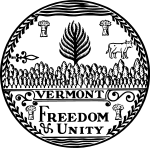| |||||||||||||||||||
| ← RIWA → | |||||||||||||||||||
22 delegates to the Democratic National Convention (15 pledged, 7 unpledged) The number of pledged delegates received is determined by the popular vote | |||||||||||||||||||
|---|---|---|---|---|---|---|---|---|---|---|---|---|---|---|---|---|---|---|---|
| |||||||||||||||||||
 County results
County results Municipality resultsGore: 40–45% 45–50% 50–55% 55–60% 60–65% 65–70% 70–75% 75–80% 80–85% 95–100%
Municipality resultsGore: 40–45% 45–50% 50–55% 55–60% 60–65% 65–70% 70–75% 75–80% 80–85% 95–100%Bradley: 45–50% 50–55% 55–60% 60–65% 65–70% 80–85% 85–90% Tie: No votes: | |||||||||||||||||||
| Pledged national convention delegates | |
|---|---|
| Type | Del. |
| CD at-large | 10 |
| PLEO | 2 |
| At-large | 3 |
| Total pledged delegates | 15 |
The 2000 Vermont Democratic presidential primary took place on March 7, 2000, as one of 16 contests scheduled on Super Tuesday in the Democratic Party primaries for the 2000 presidential election, following the Washington primary the week before. The Vermont primary was an open primary, with the state awarding 22 delegates towards the 2000 Democratic National Convention, of which 15 were pledged delegates allocated on the basis of the results of the primary.
Vice president Al Gore won the primary by a closer margin than other contests, gaining over 50% of the vote and 9 delegates. Senator Bill Bradley gave a strong performance with almost 44% of the vote and kept the delegate count close, but was not competitive enough to gain any momentum going forward. Bradley would go on to withdraw at the end of the week after failing to win a single contest.
Procedure
Vermont was one of 15 states and one territory holding primaries on Super Tuesday.
Voting took place throughout the state from 5:00 a.m. until 7:00 p.m., candidates had to meet a threshold of 15 percent in order to be considered viable. The 15 pledged delegates to the 2000 Democratic National Convention were allocated proportionally on the basis of the results of the primary. Of these, 10 were formally allocated as district delegates on the basis of the statewide result (by definition coterminous with the state's sole congressional district) and another 2 were allocated to party leaders and elected officials (PLEO delegates), in addition to 3 at-large delegates, both also according to the statewide result.
After town caucuses on April 21, 2020 designated delegates for the state convention, the state convention was held on May 30, 2020 to nominate national convention district delegates, who in turn elected the 3 at-large and 2 pledged PLEO delegates for the Democratic National Convention at the national convention delegate meeting on June 13, 2020. The delegation also included 8 unpledged PLEO delegates: 4 members of the Democratic National Committee, 1 member from Congress (Senator Patrick Leahy), the governor Howard Dean, and 1 add-on.
Candidates
The following candidates appeared on the ballot:
Results
| Candidate | Votes | % | Delegates |
|---|---|---|---|
| Al Gore | 26,774 | 54.33 | 9 |
| Bill Bradley | 21,629 | 43.89 | 6 |
| Write-in votes | 525 | 1.07 | |
| Lyndon LaRouche, Jr. | 355 | 0.72 | |
| Uncommitted | - | - | 7 |
| Total | 49,283 | 100% | 22 |
References
- Fournier, Ron (March 8, 2000). "Bradley To Drop Out, Endorse Gore". AP News. Archived from the original on June 23, 2020. Retrieved June 21, 2020.
- "Presidential Primaries, Caucuses, and Conventions Chronologically - Key and Minor Dates". The Green Papers. Retrieved September 13, 2023.
- ^ "Vermont Democratic Delegation 2000". The Green Papers. December 26, 2000. Retrieved September 17, 2023.
- "PRIMARY and GENERAL ELECTIONS". Vermont Secretary of State. Retrieved September 17, 2023.
- "Election 2000: Vermont Democrat". The Green Papers. Retrieved September 17, 2023.


